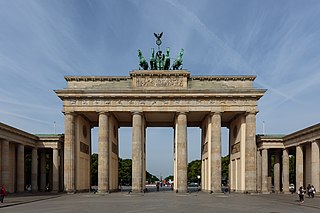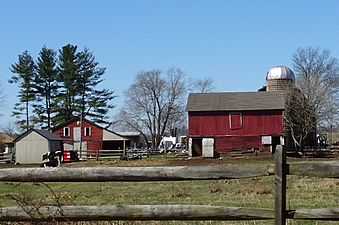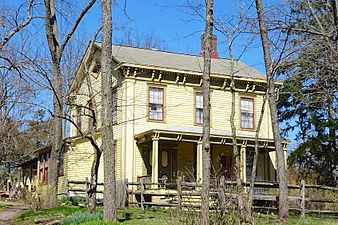
Franklin Township is a township in Somerset County, New Jersey, United States. As of the 2010 United States Census, the township's population was 62,300, reflecting an increase of 11,397 (+22.4%) from the 50,903 counted in the 2000 Census, which had in turn increased by 8,123 (+19.0%) from the 42,780 counted in the 1990 Census.

Millstone is a borough in Somerset County, New Jersey, United States. It was originally known as Somerset Courthouse and was the county seat. As of the 2010 United States Census, the borough's population was 418, reflecting an increase of 8 (+2.0%) from the 410 counted in the 2000 Census, which had in turn declined by 40 (-8.9%) from the 450 counted in the 1990 Census.
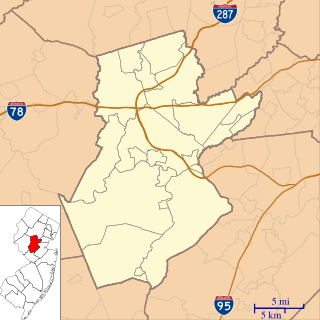
Neshanic is an unincorporated community within Hillsborough Township, in Somerset County, New Jersey, United States. It is located near the South Branch Raritan River.

Blackwells Mills is an unincorporated community and census-designated place (CDP) located in Franklin Township, in Somerset County, New Jersey, United States. As of the 2010 United States Census, the CDP's population was 803.
The Meadows Foundation of Somerset County, New Jersey is a nonprofit corporation founded in 1978. It oversaw the restoration of seven historic houses in Somerset.

The Wallace House is a Georgian style historic house, which served as the headquarters of General George Washington during the second Middlebrook encampment (1778-79), located at 38 Washington Place, Somerville, Somerset County, New Jersey, United States. It was added to the National Register of Historic Places on December 2, 1970.

Six Mile Run is an unincorporated community and census-designated place (CDP) located in Franklin Township, in Somerset County, New Jersey, United States. As of the 2010 United States Census, the CDP's population was 3,184.

The Franklin Inn was built by Cornelius Van Liew in 1752. Located at 2371 Amwell Road, East Millstone, New Jersey. Originally it was the Van Liew farmhouse, it has also been known as Annie Van Liew's house and, after being remodeled into a tavern and inn, the Franklin House Hotel.

The Wyckoff-Garretson House is a historic house located at 215 South Middlebush Road, Somerset, New Jersey which was built in 1730 by Cornelius Wyckoff. It is a contributing property of the Six Mile Run Historic District, added to the National Register of Historic Places on October 25, 1995.

The Hotchkissville Historic District is a historic district in the town of Hotchkissville, Connecticut adjacent to Woodbury, Connecticut that was listed on the National Register of Historic Places in 1995. It encompasses most of the historic village of Hotchkissville, which is centered at the junction of Washington and Weekeepeemee Roads. The village began as a dispersed rural agricultural community, but developed in the 19th century with the arrival of industry, primarily the manufacture of textiles. Despite this, the village has retained a significantly rural character, and includes a broad cross-section of 18th- and 19th-century architectural styles. Notable residents include the Wols family.

The Graniteville Historic District is a mainly residential historic district in Waterford, Connecticut. It is ranged along Rope Ferry Road, near granite quarries that were once a major industry in the town. Most of the 31 historical buildings in the district are plain residences occupied by quarry workers; also included are the c. 1878 Graniteville School at 239 Rope Ferry Road, and the house of John Palmer, one of the proprietors of the quarries, at 218 Rope Ferry Road. His house, a c. 1860 Italianate updating of an older house, is the most elaborate house in the district. The district was listed on the National Register of Historic Places in 2003.

The Jacobus Vanderveer House, also known as Knox House, is a U.S. Federal style house located just north of the community of Pluckemin in Bedminster Township, Somerset County, New Jersey at the junction of US 202 and 206 north of River Road. The house was added to the National Register of Historic Places on September 29, 1995, and noted as an "excellent example of a Dutch–American house". The Vanderveer /Knox House & Museum while owned by Bedminster Township, is operated under the direction of the Friends of the Jacobus Vanderveer House, a 501-C3 non-profit organization. The Jacobus Vanderveer House is situated on part of the 218 acres (0.88 km2) that make up River Road Park. The house was thought to be built somewhere in the mid-1770s by James (Jacobus) Vanderveer, son to Jacobus Vanderveer after the property was willed to him by his father.

The Middlebush Village Historic District is a historic district located in the Village of Middlebush, an unincorporated community within Franklin Township, Somerset County, New Jersey. The district was added to the National Register of Historic Places on April 24, 2007. It includes 37 contributing buildings and three contributing sites.

Colonial Farms, also known as the Voorhees House, is located at 1719 Amwell Road in the Middlebush section of Franklin Township, Somerset County, New Jersey, United States. It was built in 1793 by P. Metz in a Georgian style. It is part of the Middlebush Village Historic District. The oldest building in the district, it was used in 1834 to organized the Middlebush Reformed Church. The location also includes a contributing large, red shingle, 19th-century Dutch barn. It is now the Stage House Tavern.

The Millstone Historic District is a historic district located in Millstone, Somerset County, New Jersey. The district was added to the National Register of Historic Places on September 13, 1976.

The Parker Hill Rural Historic District encompasses a large rural agricultural landscape in eastern Windham and Windsor counties in the US state of Vermont. Roughly centered on Parker Hill Road in northern Rockingham and southern Springfield, the district exhibits a history of 200 years of farming, including a collection of Federal period farm housing. The district was listed on the National Register of Historic Places in 1993.

The Millstone Valley Agricultural District is a historic district located south of Millstone on the western side of the Millstone River along River Road / County Route 533 in Hillsborough Township, Somerset County, New Jersey. The district was added to the National Register of Historic Places on August 10, 1977.
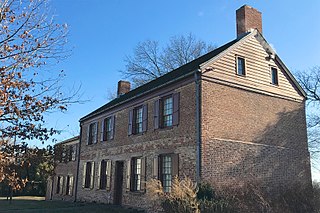
The Van Veghten House is a historic building in the Finderne section of Bridgewater Township, Somerset County, New Jersey. The house was built c. 1725 and served as the headquarters of Quartermaster General Nathanael Greene during the second Middlebrook encampment (1778–79) in the American Revolutionary War. The Somerset County Historical Society has the house as its headquarters, including a museum and library. The early-18th-century Old York Road, connecting Philadelphia to New York City, passed by here. The house was added to the National Register of Historic Places on October 10, 1979, and noted as representing "one of the few remaining Raritan River mansions".









